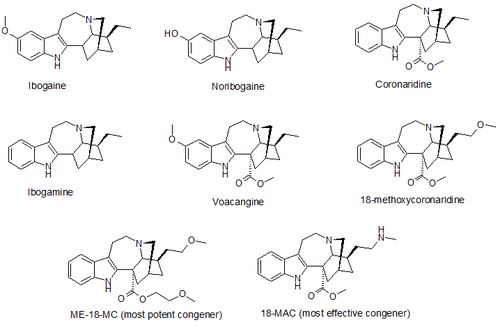18-Methoxycoronaridine
(–)-18-Methoxycoronaridine (18-MC) is a derivative of ibogaine invented in 1996 by the research team around the pharmacologist Stanley D. Glick from the Albany Medical College and the chemist Martin E. Kuehne from the University of Vermont. In animal studies it has proved to be effective at reducing self-administration of morphine, cocaine, methamphetamine, nicotine and sucrose.[1] [2] 18-MC is a α3β4 nicotinic antagonist and, in contrast to ibogaine, has no affinity at the α4β2 subtype nor at NMDA-channels nor at the serotonin transporter,[3] and has significantly reduced affinity for sodium channels and for the σ receptor, but retains modest affinity for μ-opioid receptors where it acts as an antagonist,[4] and κ-opioid receptors.[5] The sites of action in the brain include the medial habenula, interpeduncular nucleus,[6][7][8] dorsolateral tegmentum and basolateral amygdala.[9] It has also been shown to produce anorectic effects in obese rats, most likely due to the same actions on the reward system which underlie its anti-addictive effects against drug addiction.[10]
 | |
| Clinical data | |
|---|---|
| Routes of administration | oral |
| Legal status | |
| Legal status |
|
| Identifiers | |
IUPAC name
| |
| CAS Number | |
| PubChem CID | |
| ChemSpider | |
| UNII | |
| CompTox Dashboard (EPA) | |
| Chemical and physical data | |
| Formula | C22H28N2O3 |
| Molar mass | 368.47 g/mol g·mol−1 |
| 3D model (JSmol) | |
SMILES
| |
InChI
| |
| | |
18-MC is in the early stages of human testing by the California-based drug development company Savant HWP.[11] In 2002 the research team began raising funds for human trials, but were unable to secure the estimated $5 million needed.[12] In 2010, Obiter Research, a chemical manufacturer in Champaign, Illinois, signed a patent license with Albany Medical College and the University of Vermont, allowing them the right to synthesize and market 18-MC and other congeners. In 2012 the National Institute on Drug Abuse gave a $6.5 million grant to Savant HWP for human trials.[11]
A number of derivatives of 18-MC have been developed, with several of them being superior to 18-MC itself, the methoxyethyl congener ME-18-MC being more potent than 18-MC with similar efficacy, and the methylamino analogue 18-MAC being more effective than 18-MC with around the same potency. These compounds were also found to act as selective α3β4 nicotinic acetylcholine antagonists, with little or no effect on NMDA receptors.[13][14]

See also
- Coronaridine
- Ibogaine
- Noribogaine
- Voacangine
References
- S.D. Glick; Kuehne, ME; Maisonneuve, IM; Bandarage, UK; Molinari, HH (1996). "18-Methoxycoronaridine, a non-toxic iboga alkaloid congener: effects on morphine and cocaine self-administration and on mesolimbic dopamine release in rats". Brain Res. 719 (1–2): 29–35. doi:10.1016/0006-8993(96)00056-X. PMID 8782860.
- Glick, Stanley D.; Sell, Elizabeth M.; Maisonneuve, Isabelle M. (2008). "Brain regions mediating α3β4 nicotinic antagonist effects of 18-MC on methamphetamine and sucrose self-administration". European Journal of Pharmacology. 599 (1–3): 91–5. doi:10.1016/j.ejphar.2008.09.038. PMC 2600595. PMID 18930043.
- I.M. Maisonneuve; Glick, SD (2003). "Anti-addictive actions of an iboga alkaloid congener: a novel mechanism for a novel treatment". Pharmacol. Biochem. Behav. 75 (3): 607–18. doi:10.1016/S0091-3057(03)00119-9. PMID 12895678.
- Antonio T, Childers SR, Rothman RB, et al. (2013). "Effect of Iboga alkaloids on µ-opioid receptor-coupled G protein activation". PLoS ONE. 8 (10): e77262. doi:10.1371/journal.pone.0077262. PMC 3818563. PMID 24204784.
- Glick SD, Maisonneuve IM, Hough LB, Kuehne ME, Bandarage UK. (±)-18-Methoxycoronaridine: A Novel Iboga Alkaloid Congener Having Potential Anti-Addictive Efficacy. CNS Drug Reviews 1999;5(1):27-42.
- Glick, SD; Ramirez, RL; Livi, JM; Maisonneuve, IM (2006). "18-Methoxycoronaridine acts in the medial habenula and/or interpeduncular nucleus to decrease morphine self-administration in rats". European Journal of Pharmacology. 537 (1–3): 94–8. doi:10.1016/j.ejphar.2006.03.045. PMID 16626688.
- Taraschenko, OD; Shulan, JM; Maisonneuve, IM; Glick, SD (2007). "18-MC acts in the medial habenula and interpeduncular nucleus to attenuate dopamine sensitization to morphine in the nucleus accumbens". Synapse. 61 (7): 547–60. doi:10.1002/syn.20396. PMID 17447255.
- Taraschenko, OD; Rubbinaccio, HY; Shulan, JM; Glick, SD; Maisonneuve, IM (2007). "Morphine-induced changes in acetylcholine release in the interpeduncular nucleus and relationship to changes in motor behavior in rats". Neuropharmacology. 53 (1): 18–26. doi:10.1016/j.neuropharm.2007.04.010. PMC 2025684. PMID 17544456.
- Glick, SD; Sell, EM; Maisonneuve, IM (2008). "Brain regions mediating α3β4 nicotinic antagonist effects of 18-MC on methamphetamine and sucrose self-administration". European Journal of Pharmacology. 599 (1–3): 91–5. doi:10.1016/j.ejphar.2008.09.038. PMC 2600595. PMID 18930043.
- Taraschenko, OD; Rubbinaccio, HY; Maisonneuve, IM; Glick, SD (2008). "18-methoxycoronaridine: a potential new treatment for obesity in rats?". Psychopharmacology. 201 (3): 339–50. doi:10.1007/s00213-008-1290-9. PMC 3787601. PMID 18751969.
- Albany Med scientist closer to addiction drug success timesunion.com June 27, 2014.
- Addiction Treatment Strives for Legitimacy. Journal of the American Medical Association. 2002; 288: 3096-3101.
- Kuehne, ME; He, L; Jokiel, PA; Pace, CJ; Fleck, MW; Maisonneuve, IM; Glick, SD; Bidlack, JM (2003). "Synthesis and biological evaluation of 18-methoxycoronaridine congeners. Potential antiaddiction agents". Journal of Medicinal Chemistry. 46 (13): 2716–30. doi:10.1021/jm020562o. PMID 12801235.
- Pace, CJ; Glick, SD; Maisonneuve, IM; He, LW; Jokiel, PA; Kuehne, ME; Fleck, MW (2004). "Novel iboga alkaloid congeners block nicotinic receptors and reduce drug self-administration". European Journal of Pharmacology. 492 (2–3): 159–67. doi:10.1016/j.ejphar.2004.03.062. PMID 15178360.
Further reading
- S.D. Glick; Ramirez, RL; Livi, JM; Maisonneuve, IM (2006). "18-Methoxycoronaridine acts in the medial habenula and/or interpeduncular nucleus to decrease morphine self-administration in rats". Eur. J. Pharmacol. 537 (1–3): 94–8. doi:10.1016/j.ejphar.2006.03.045. PMID 16626688.